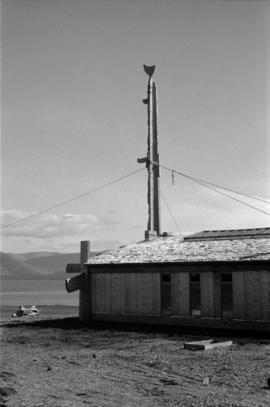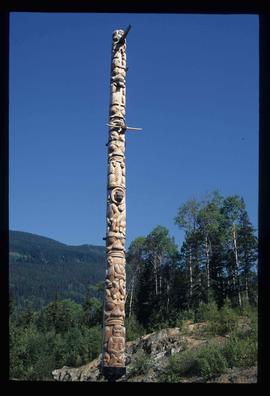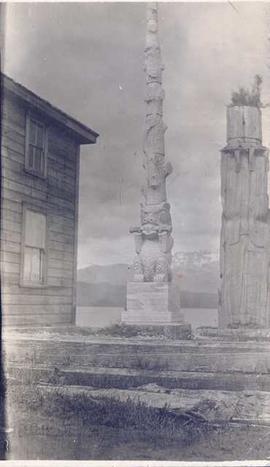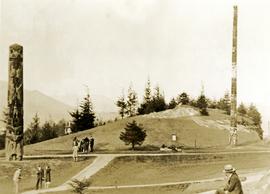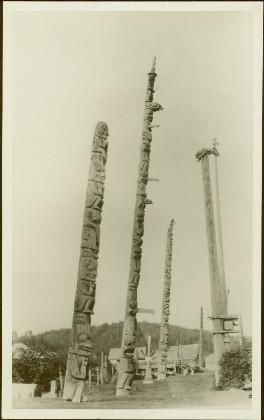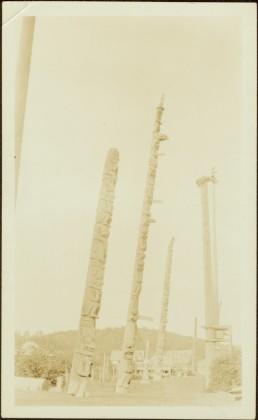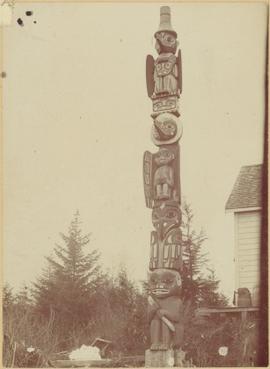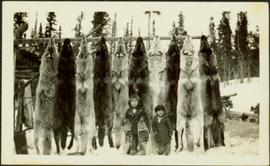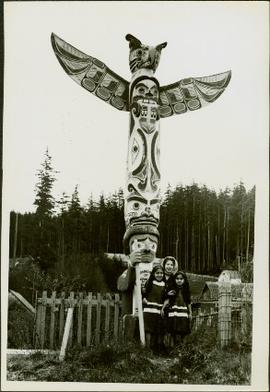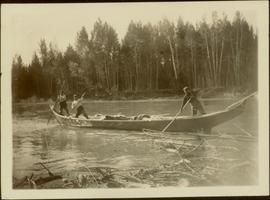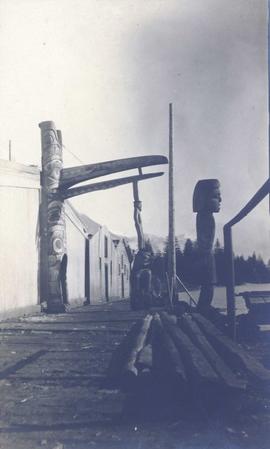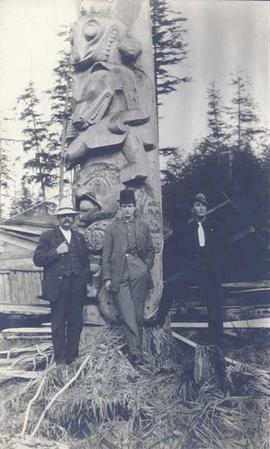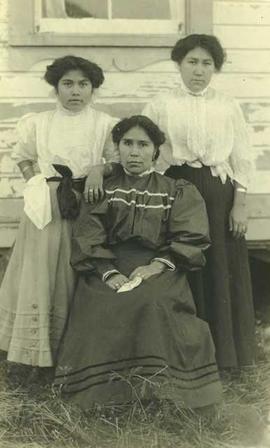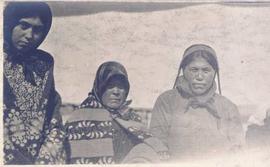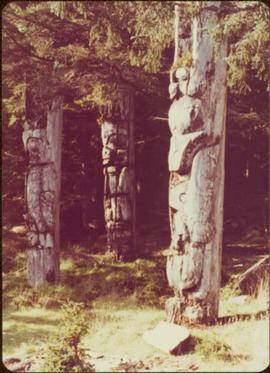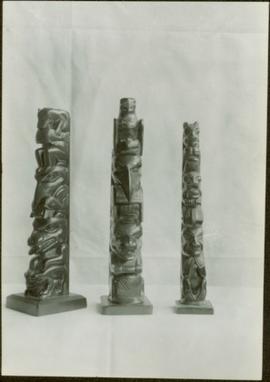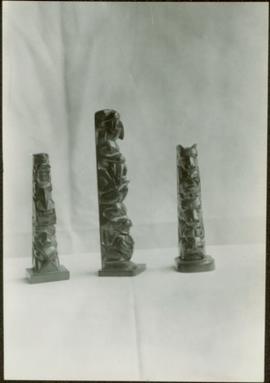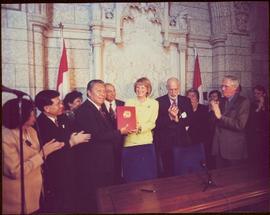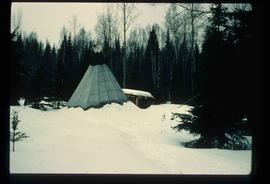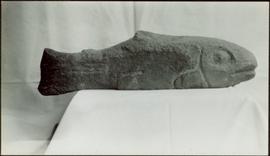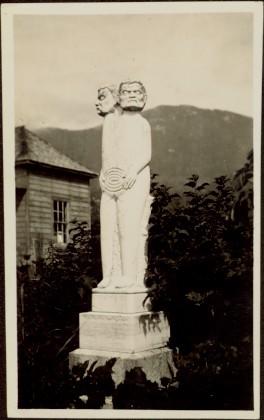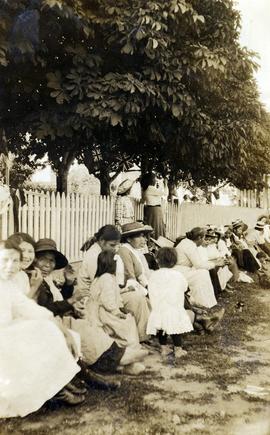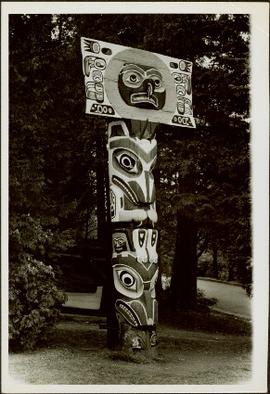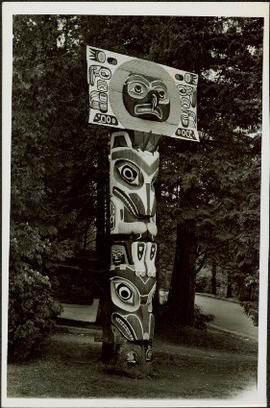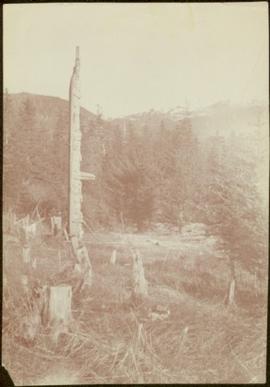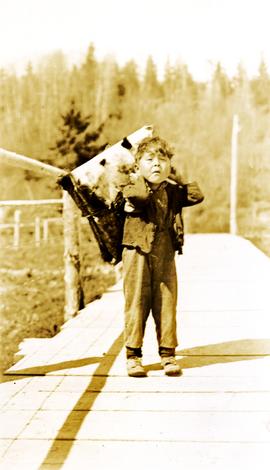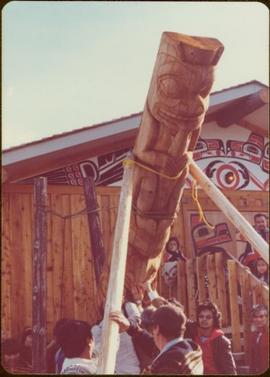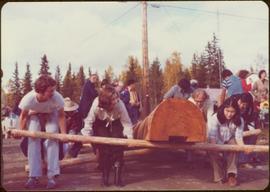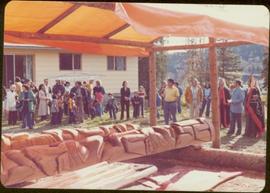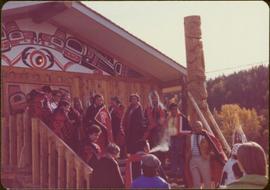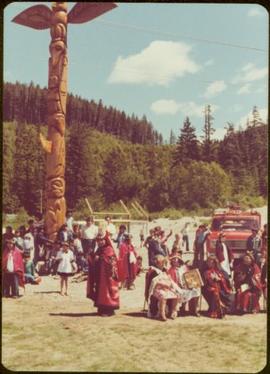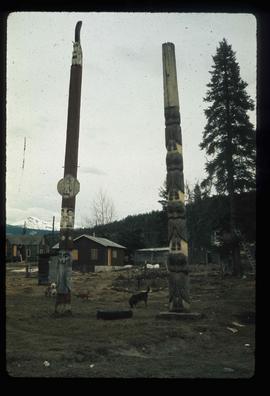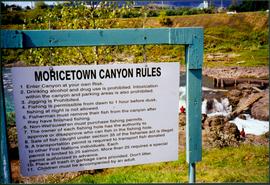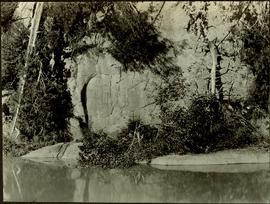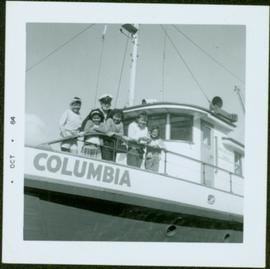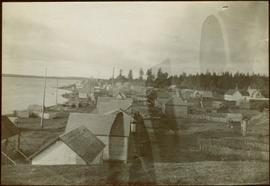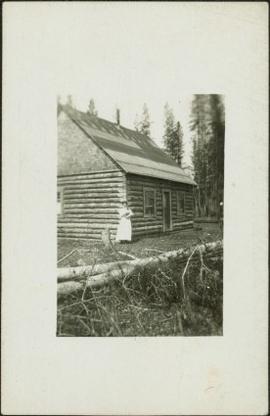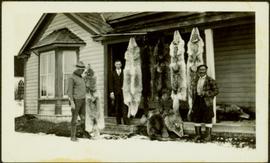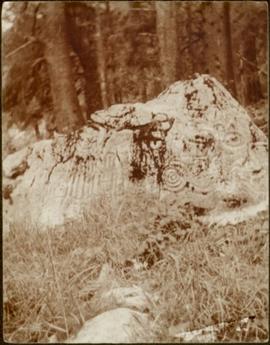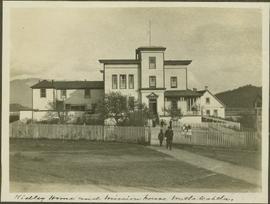Photograph depicts a rear view of a totem pole supported by ropes at Skidegate museum, Queen Charlotte Islands.
Image depicts a totem pole at an uncertain location, possibly in Gitwinksihlkw, B.C.
Photograph depicts a totem pole and a tall wooden plant holder in front of a body of water.
Groups of men and women can be seen gathered on paths between two large totem poles.
Handwritten annotation on verso reads: "Totem Park Pr Rupert park."
Miscellaneous items are scattered in yard behind totem, house partially visible in background.
Handwritten annotation on verso reads: "Insert this illustration in Chapt. II. No. 2. 'Tlingit Totem.'"
Photograph depicts two small children standing with snowshoes in front of wolf pelts hung from a pole in snow-cleared area, miscellaneous items throughout. Forest in background. Typed annotation on recto of photograph: "Wolf pelts, taken at Teslin Lake B.C." See also items 2009.5.2.66 & 2009.5.2.67.
Photograph depicts three young, First Nations girls standing in front of a memorial totem pole with houses and a forested environment visible in the background. Photographer’s stamp on verso: “W.E. Nicholson, 268 E. 10th, Vancouver 10, B.C.”
Handwritten annotation on verso reads: "Poling supplies up Nass River".
Photograph depicts three Indigenous totem carvings in front of various buildings on the shoreline.
Photograph depicts three unidentified men standing in front of an Indigenous totem pole.
Photograph depicts three First Nations women posed in front of a house.
Photograph depicts three First Nations women facing the camera.
Forest in background.
Three model totem poles carved out of argillite and of various heights standing as a trio against a white backdrop. Handwritten annotation in pen on verso reads: “W.E. Collison.” Stamped annotation on verso reads: “Department of Mines and Resources, Photographic Section. Oct. 6, 1939”. Numeric annotation on verso: “43-3”
Three model totem poles carved out of argillite and of various heights standing as a trio against a white backdrop. Handwritten annotation in pen on verso reads: “W.E. Collison.” Stamped annotation on verso reads: “Department of Mines and Resources, Photographic Section. Oct. 6, 1939”. Numeric annotation on verso: “43-5”
Item is a audio interview recorded by Bridget Moran with Justa Monk.
Audiocassette Summary
00’ 10” Moran asks Theresa about when she first started living with Justa. They discuss the beginning of their relationship. Theresa discusses her former husband, how she began drinking because of his abuse. She says Justa made her settle down.
11’ 22” Moran asks Theresa about the things her and Justa do together. She says they garden. She says he looks after her well, but in the past Justa ‘slapped her around’ when they were drinking. Theresa talks about her past with alcoholism and how it affected her relationship with Justa.
18’ 30” Moran asks about when Justa and Theresa got married. Theresa talks about the wedding. Theresa talks about how Justa’s parents initially did not accept her, but they eventually started to treat her well when they saw Justa and her were doing well.
21’ 35” Moran asks Theresa about her children. Theresa discusses them all individually. Two of her daughters were killed.
31’ 45” Moran asks Theresa about going to Tachie for salmon fishing. Theresa talks about the process of fishing from the shore. Theresa also talks about hunting and preparing for the winter.
37’ 45” Moran tells Theresa no names will be mentioned in the book, such as the last name of her first husband.
37’ 59” Moran asks Theresa why she thinks alcoholism is such a problem on the reserves nowadays.
42’ 59” End of tape.
Item consists of the Kohklux map originally created by Chief Chilkaht Kohklux of Tlingit in 1852. This is one of the earliest known maps of the southern Yukon. Map originally inserted into a book about the map.
The group stands in front of an ornate stone wall and two Canadian flags.
Handwritten annotation on photograph enclosure reads: “8/6/99. Dear Lady, When I saw this photograph I knew there was a certain person who would truly appreciate and ‘feel’ its significance. Not many steps left to take now . . . . your unwavering support is never more appreciated. best personal regards, Peter”; handwritten annotation on verso reads: “Nisga’a”.
Image depicts what appears to be a teepee at an uncertain location.
Item is a audio interview recorded by Bridget Moran with Jimmy, Rosie, Nancy, and Madeline.
Audiocassette Summary
00’ 05” Continuation of interview with Jimmy. Jimmy says his grandfather is French, not German, like Justa thinks. Moran and Jimmy continue to talk about the history of his grandparents. Jimmy continues to talk about his family history. They talk about the history of their last name, Monk.
12’ 08” Interview changes to Rosie. Moran asks Rosie about her siblings and other family history. Moran asks about the history of their last name, Monk. She believes her descendants are French. They continue to talk about her family history.
19: 22” Moran asks Rosie about the time Justa murdered John. Rosie talks about the situation candidly. She talks about John’s family life.
26’ 30” Moran asks Rosie about attending residential school. Rosie says school was alright for her, that they looked after them. She came home after six years.
28’ 30” Rosie talks about traveling around with her father because he worked many different jobs.
29’ 55” Rosie talks about getting married, how she got to choose her own partner, instead of having it arranged. She discusses her children.
32’ 05” Moran asks if Rosie had a good childhood. Rosie says yes, but her parents were strict. She remembers her father having to pay a land tax because they did not live on reserve land. She continues to talk about her childhood.
37’ 16” Rosie talks about life in residential school. Nancy says the nuns were kind; that they had to punish them if they spoke their native language.
38’ 50” Interview changes to Nancy. Moran asks about the history of their last name, Monk. They talk about her family history.
45’ 43” Moran asks Nancy about the time Justa killed his brother, John. Nancy talks about what she can remember.
47’ 32” Moran asks Nancy about the death of her brother, Teddy. She tells Moran the story she was told by the police.
49’ 34” Moran asks Nancy when she went to residential school. Nancy talks about having convulsions, so only spent two years there, then came home. When she was feeling better, she went back for another two years. She said her time there was not that bad, but she was homesick and lonely.
53’ 16” Moran asks Nancy if she had a good childhood. Nancy tells her she did, that they did everything for their parents.
56’ 07” Interview changes to Madeline. Moran asks about the history of their last name, Monk. Madeline does not know much about it. They continue to talk about the history of the family.
1:02’ 45” Madeline tells Moran about how she knocked Justa out with a block of ice because he was teasing her when they were children. Justa was a big tease, she says. Madeline says that Justa collected a box full of ‘treasure.’
1:09’ 10” Moran asks Madeline about her mother and how much she sewed for other people.
1: 10’ 44” Moran asks about when Madeline went to residential school. She tells Moran that she liked it there. Those who went there have discipline, she says.
1: 12’ 55” Madeline tells Moran that her parents were strict. She talks about being punished when breaking the rules, much like being at the residential school. They return to discussing residential school.
1: 17’ 55” Moran asks Madeline about what she remembers about the trips between Portage and Fort St. James. She talks about traveling by canoe once with her grandfather.
1: 20’ 33” Moran tells Madeline what she plans to write about in the book, particularly the first chapter dealing with the family history and life before the road being built to Portage.
1: 23’ 25” They return to talking about the family history, including aunts. They talk about her siblings.
1:30’ 07” Moran asks about Justa Hanson, the man Justa was named after. He was living in Tachie at the time Justa was born.
1:32’ 40” End of tape.
Item is a audio interview recorded by Bridget Moran with Justa Monk's family members.
Audiocassette Summary
00’ 05” Moran is talking to Justa’s sister, Adelle. She says the old way of life is better than life today. They talk about the lack of gardens in Tachie today.
02’ 45” Adelle talks about the family history, particularly her father. She talks about their way of life when they were children. Adelle continues to talk about her past.
08’ 40” Adelle talks about the residential school and how she was upset she was when she was sent there. She talks about being punished for speaking their native language. She was at the residential school until the age of sixteen.
12’ 13” Moran asks Adelle about what she remembers about fishing. She talks about the process of fishing.
13’ 22” Adelle talks about her individual history. She talks about not getting married at all because she could not marry the man she wanted. She talks about getting tuberculosis and being in the hospital for a year. When she was released from the hospital, she moved in with a man who was abusive towards her. She talks about leaving him and moving to Prince George, eventually.
18’ 56” Adelle talks about how it was beneficial that her parents were strict. She continues to talk about her childhood, particularly Christmas.
24’ 36” Moran and Adelle talk about when Justa killed his brother. Adelle tells Moran that Justa looked after his brother’s children after he was released from prison.
26’ 08” Moran asks Adelle about whether she drank or not. Adelle says when she moved to Prince George she began to drink heavily.
27’ 35” Moran asks Theresa about the time her and Justa got married. Adelle tells Moran that Justa was the baby of the family and how his siblings ‘babied’ him, hence why his mother was so upset when he married Theresa.
31’ 00” Interview changes to Theresa’s mother. Theresa’s mother speaks in her native language most of the time and Theresa translates. They talk about her past, particularly where and when she was born. They talk about how many families lived in Tachie.
40’ 13” Moran asks about whether Theresa’s mother went to Fort St. James often before the road was built. When they went to Fort St. James, by horse, they would buy some groceries.
43’ 04” They continue to talk about Theresa’s mother’s past.
47’ 33” Moran interviews Jimmy, Justa’s brother. She begins by asking him with the road being built. He tells her life was better in the old days because it was cheaper.
50’ 10” Moran asks about the family history. Jimmy lists the siblings from oldest to youngest.
52’ 05” Jimmy tells Moran that he did not go to the residential school because his grandfather would not let him. Jimmy needed to work for the family because he was the oldest. He talks about everything being done by hand.
58’ 00” Moran asks Jimmy about the type of house that his parents lived in when he was born. He talks about his childhood and his way of life. He talks about helping building a house with his father that had no rooms.
1: 02” 53” Moran asks Jimmy when he got married. Jimmy talks about his wife’s family, particularly his father-in-law, who Justa was named after.
1: 04’ 58” Moran asks Jimmy his memories about living in Portage. He tells her he was a bad kid. He also talks about the trips he took to the surrounding areas. He tells her it was a hard life, but there were good things.
1:10’ 35” Moran asks Jimmy about any memories he has of Justa as a kid. Jimmy tells her that even as a kid, Justa was pretty smart. Jimmy would take him to collect hay. Justa was called the baby and was spoiled too much.
1: 13’ 09” Moran asks Jimmy where he was when Justa got in trouble with his brother. Jimmy said he had a feeling something bad was going to happen, so decided to go home. He talks about when he was told about the murder. Moran continues to ask about the situation, but Jimmy tells her he is still not sure what happened between Justa and John.
1:25’ 03” Jimmy talks about making his store bigger at the pressure of Indian Affiars, but it was too much to keep operating, so now there is only a store that sells junk food.
1:28’ 47” Jimmy talks about the loss of two of his children. He continues to discuss his children.
1: 34’ 36” End of tape.
Item is a print of a photograph of a stone totem pole at Metakatla taken between 1906 and 1908.
Stone figure carved in the likeness of a fish. Stamped annotation on verso reads: “Department of Mines and Resources, Photographic Section. Oct. 6, 1939”. Numeric annotation on verso: “48-5”
Photograph depicts a figure with two heads standing above stone reading "Here lies the last but not the least because He is the last of all his line the [?] Tribe ABEL WARD SOLOMON WARD". Bushes, building, and hill visible in background.
Handwritten annotation on verso reads: "Port Simpson BC".
Photograph depicts a row of spectators wearing nice clothing, sitting on the curb in the shade of mature chestnut trees. Many of the spectators appear to be Indigenous women and children. They may be gathered to watch a parade or special event. There are Union Jacks and Canadian Red Ensign flags hanging in the trees, suggesting the event may be a Dominion Day event. Although the location is unknown, the presence of the chestnut trees suggests that this may have been taken on Lillooet Main Street.
Item is a recording of an interview that Bridget Moran conducted with Elder Sophie Thomas and Elder Mary John on the circumstances surrounding the death of her niece, Coreen Gay Thomas who was hit by a car in Stoney Creek in 1976 by a white man. During the interview they are joined by Elder Mary John who also answers questions about Coreen’s death. In the remainder of the interview Bridget asks Sophie about her own life; Sophie talks about being “married off” at 16 years of age; and experiences at the residential school at LeJac.
Audiocassette Summary
Side 2
00’05” Moran asks Sophie about the night that Coreen died and how Sophie learned the news
06’00” Sophie explains who came and told her the news. Sophie describes having to go to the morgue and assisted the nurses in preparing Coreen’s body for burial before being brought back to the reserve for the funeral. Sophie recalls telling the youth who were witnesses to the accident to speak the truth when being interviewed by the RCMP.
07’00 Sophie talks about her reaction to hearing that there was not going to be an inquest into Coreen’s death. She talks about her decision to fight against this and recalls how she notified the BC Association of Indian Homemakers requesting its assistance and how it sent a representative member Kitty [Bell] with the BC Indian Homemakers who interviewed Sophie, other Stoney Creek members and accident witnesses and that a letter was sent to the Coroner urging an inquest. Bridget refers to an article in the PG Citizen newspaper quoting Sophie on her desire for an inquest and they discuss the context of this quote. Sophie talks about her encounter with the Judge to request an inquest. She talks about how he [Judge Eric Turner] had himself caused a hit and run accident and how this may have initially been his rationale not to have an inquest into Coreen’s death.
15’00 Bridget asks about how Coreen’s parents found out about the accident and why the RCMP didn’t notify them. Sophie and Mary John discuss the questioning of Coreen’s sister [Marjorie who was with Coreen at the time of the accident] at the RCMP headquarters in Vanderhoof. Mary John joins the interview and Bridget asks her how she found out about Coreen’s death.
20’00 Both Sophie and Mary talk about Coreen, that she attended St. Joseph’s School to Grade 7. They note she babysat for families in the community. Sophie notes that Coreen and her boyfriend were planning to marry after the baby was born as “that was our custom” and had bought their wedding rings. He was at the Williams Lake Stampede at the time of the accident.
Tape turned off momentarily.
24’00 Bridget then interviews Sophie about her own early married life and about getting married at age 16 and the reasoning for this. Sophie explains that she did not want to get married but that the ‘watchman’ [at the Lejac school] insisted she get married as she couldnot remain at the school. Sophie explains that was the ‘school law’ as the school didn’t want to keep them after age 16; Bridget surmises that it may have been the policy of the Department of Indian Affairs so as not to pay for further education. Sophie notes it was 1932 when she married [Maurice Thomas]; that she didn’t know her husband before; that he was 25 years old and from another village. She explains they got married and she spent 2 days at her mother-in-law’s house alone before joining him. They lived in a log cabin on his grandfather’s land.
29’00 Bridget then asks about the role of the ‘watchman’ at the school; about whether the priests (Father Coccola and Father Joseph) thought it was appropriate to marry off young girls. Sophie recalls the time at the school when she ran off; she notes that ‘religion was so strong’ that they had to get married. She recalls the strictness of the school and how pupils were punished by the priests; she refers to some boys being tied down and lashed.
33’00-34’00 Sophie notes her maiden name was George. She recalls how at the time of her wedding that the priest [?] wanted to have a ‘free dance’ for her wedding as entertainment. She remarks how odd the custom was to her; she explains that there is no dancing at a native wedding.
End of Side 2
Consists of an audio recording made by Paul of songs sung by Mrs. Danny William, Mrs. E. Sammy, Mrs. Peter William, and Mrs. Patrick Andy.
Photograph depicts a small totem pole in front of trees and a roadway. Photographer’s stamp on verso: “W.E. Nicholson, 268 E. 10th, Vancouver 10, B.C.”
Photograph depicts a small totem pole in front of trees and a roadway. Photographer’s stamp on verso: “W.E. Nicholson, 268 E. 10th, Vancouver 10, B.C.”
Child stands in distance beside tall totem pole. Tree stumps in foreground, forest and mountains in background.
Handwritten annotation on verso reads: "[Sanabati near Upper Queen?] Kasaan Alaska".
Unidentified boy walks on a wood boardwalk, carrying large bundle. Forest in background.
Handwritten annotations on verso read: "Young boy carrying furs - Village of Kincolith"; "Little Indian boy carrying bear skin [?] at Gitlakdamix".
Photograph depicts close-up of unidentified skeletal remains situated on the ground. Handwritten annotation in pen on verso reads: “skeleton fallen from burial box at Masset QCIs. Remains were buried near original site”.
Crowd stands in background.
Handwritten annotation on verso reads: “Fall 1978, Kispiox, 2 Poles by Walter Harris”.
Unidentified building stands in midground, water and hill on opposite shore visible in background.
Handwritten annotation on verso reads: “Kispiox”.
Forest in background.
Handwritten notation included with photograph reads: “The ‘Beloved North,’ Skeena Riding (always)”.
Image depicts two totem poles in Skeena Crossing, B.C.
Photograph depicts sign in foreground outlining rules and restrictions for behaviour at Moricetown Canyon. Traditional fishing territory visible behind sign at waterfall in the Bulkley River, B.C. Highway and buildings can be seen in background.
Petroglyphs featuring coppers painting onto a rock face next to a lake.
Handwritten annotation in pencil on verso reads: “As seen from the R.R. track. By Harlan I. Smith. 4 poles E of 92 mile or about 1 ½ meter E. of Tyce, B.C., Red Pictograph, Note: head above and to the right at the left of log top in shadow of cedar.” Stamped annotation on verso reads: “Department of Mines Geological Survey Photographic Division, January 21 1926” – in pen above this stamped date is written “7-10-1925”.
Photograph depicts five First Nations children and a ship captain on the deck of the M.S. Columbia. Stamped annotation on recto states: “Oct – 64”
Photograph depicts village buildings along shore.
Handwritten annotation on verso reads: "67 Section of Massett as it is".
Footage of a horse ranch called "Cless Pocket Ranch" and hay fields surrounding. There is men at work using a sawmill to cut wood into planks and men working in the hay field with their young sons on the ranch. Cless Pocket Ranch is located in the Chilcotin area of BC near Anahim Lake.
Also included is footage of the Anahim Lake stampede, the people watching and playing, the arena and the concession stand.
Photograph depicts Sarah Glassey, holding her fox terrier, and standing at corner of log house. Felled trees in foreground, forest trees in background. Photograph believed to have been taken on the 160 acres of land which Sarah purchased in the Kispiox Valley in 1911. She became the first single woman to pre-empt land in British Columbia. This house was built in a year with the help of a Gitxsan Elder.
Photograph depicts an unidentified First Nations man standing to right of wolf pelts that hang from eaves of house in Atlin, B.C. Stewart and Glassey stand on left, Glassey wearing a suit and tie. Typed annotation on recto of photograph: "Wolf pelts from Teslin, B.C.", handwritten: "Ron Stewart is policeman." See also items 2009.5.2.67 & 2009.5.2.68.
Carvings visible on a moss covered rocky outcrop. Handwritten annotation in pencil on verso reads: “Rock carvings. Copper Mountain, Al”.
Photograph depicts an unidentified man walking on path in front of Bishop Ridley's home. Several children can be seen in fenced yard in midground.
Handwritten annotation below image reads: "Ridley Home and Mission house Metlakahtla."; on verso: "Chapter XXVII / Heading for Chapter / Ridley Home Metlakahtla".
Item is a presentation of research about the transfer of Aboriginal knowledge to early female scientists for Ainley's Social Science and Research Humanities Council (SSHRC) project, "Re-explorations: Gender, Science and Environment in the 19th and 20th Century Canada and Australia."
